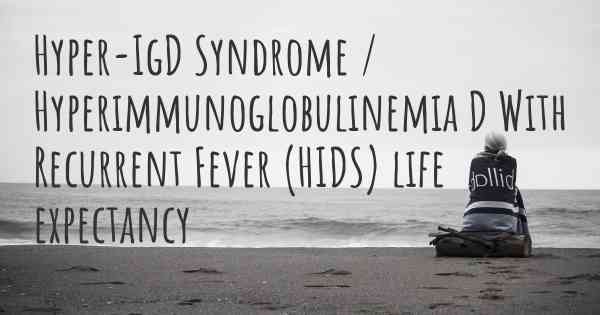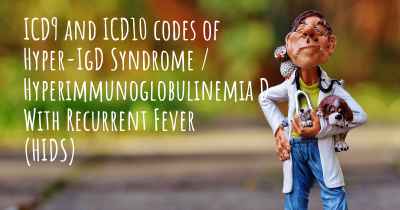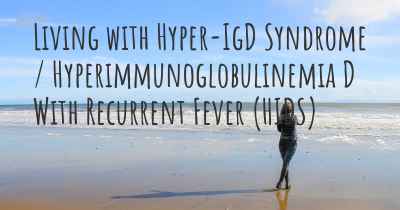What is the life expectancy of someone with Hyper-IgD Syndrome / Hyperimmunoglobulinemia D With Recurrent Fever (HIDS)?
Life expectancy of people with Hyper-IgD Syndrome / Hyperimmunoglobulinemia D With Recurrent Fever (HIDS) and recent progresses and researches in Hyper-IgD Syndrome / Hyperimmunoglobulinemia D With Recurrent Fever (HIDS)

Hyper-IgD Syndrome, also known as Hyperimmunoglobulinemia D With Recurrent Fever (HIDS), is a rare genetic disorder characterized by recurrent fevers, abdominal pain, joint pain, and skin rashes. The severity and frequency of symptoms can vary widely among individuals.
The life expectancy of someone with HIDS can vary depending on various factors, including the specific genetic mutation and the management of symptoms. While there is no cure for HIDS, treatment options such as medications to control inflammation and fever, as well as lifestyle modifications, can help manage symptoms and improve quality of life.
It is important for individuals with HIDS to work closely with healthcare professionals to develop a personalized treatment plan. With proper management, individuals with HIDS can lead fulfilling lives, although the long-term prognosis can vary.
Hyper-IgD Syndrome (HIDS), also known as Hyperimmunoglobulinemia D With Recurrent Fever, is a rare genetic disorder that affects the immune system. It is characterized by recurrent episodes of fever, accompanied by various symptoms such as abdominal pain, joint pain, skin rashes, and swollen lymph nodes. HIDS is caused by mutations in the mevalonate kinase (MVK) gene, which leads to the overproduction of a protein called mevalonate kinase.
The life expectancy of individuals with HIDS can vary widely depending on several factors, including the severity of symptoms, the presence of complications, and the effectiveness of treatment. It is important to note that HIDS is a chronic condition, and while it can significantly impact the quality of life, it is generally not considered a life-threatening disorder.
Episodes of fever are the hallmark feature of HIDS, typically lasting for 3-7 days and recurring every 4-6 weeks. These febrile episodes can be accompanied by a range of symptoms, including abdominal pain, headache, sore throat, vomiting, diarrhea, and skin manifestations such as rashes or ulcers. The severity and frequency of these episodes can vary among individuals.
Between fever episodes, individuals with HIDS usually have periods of relative wellness. However, some individuals may experience milder symptoms such as joint pain, muscle aches, fatigue, or gastrointestinal disturbances even during these periods. The impact on daily life can vary, with some individuals experiencing minimal disruption while others may have more significant limitations.
Complications associated with HIDS are generally rare but can occur. These may include the development of amyloidosis, a condition characterized by the accumulation of abnormal proteins in various organs, particularly the kidneys. Amyloidosis can lead to progressive organ damage and may affect the overall prognosis of individuals with HIDS. However, with appropriate monitoring and treatment, the risk of developing amyloidosis can be minimized.
Treatment for HIDS primarily focuses on managing symptoms and preventing complications. Nonsteroidal anti-inflammatory drugs (NSAIDs) are commonly used to control fever and relieve pain during episodes. In some cases, corticosteroids may be prescribed to reduce inflammation and suppress the immune response. Additionally, medications that target specific inflammatory pathways, such as interleukin-1 inhibitors, have shown promise in managing HIDS symptoms.
Prognosis for individuals with HIDS is generally favorable. With appropriate management and treatment, most individuals can lead relatively normal lives. The frequency and severity of fever episodes tend to decrease with age, and some individuals may even outgrow the condition in adulthood. However, it is important for individuals with HIDS to receive regular medical follow-up to monitor for complications and adjust treatment as needed.
In conclusion, Hyper-IgD Syndrome (HIDS) is a rare genetic disorder characterized by recurrent fever episodes and various accompanying symptoms. While it can significantly impact the quality of life, HIDS is generally not considered life-threatening. The life expectancy of individuals with HIDS can vary depending on factors such as symptom severity, complications, and treatment effectiveness. With appropriate management and treatment, most individuals can lead relatively normal lives and experience a favorable prognosis.








